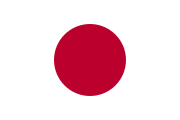Japanese people

|
|
| Total population | |
|---|---|
| c. 129 million | |
| Regions with significant populations | |
|
|
|
| Significant Japanese diaspora in: | |
|
|
1,600,000 |
|
|
1,304,286 |
|
|
140,134 |
|
|
120,000 |
|
|
109,740 |
|
|
71,013 |
|
|
67,424 |
|
|
65,000 |
|
|
63,017 |
|
|
36,960 |
|
|
30,947 |
|
|
28,320 |
|
|
28,100 |
|
|
23,000 |
|
|
22,000 |
|
|
21,297 |
|
|
20,373 |
|
|
20,000 |
|
|
14,000 |
|
|
13,447 |
|
|
12,156 |
|
|
11,263 |
|
|
9,468 |
|
|
8,499 |
|
|
8,000 |
|
|
7,046 |
|
|
7,000 |
|
|
6,616 |
|
|
6,519 |
|
|
6,000 |
|
|
5,554 |
|
|
5,000 |
|
|
4,200 |
|
|
3,949 |
|
|
3,456 |
| Languages | |
| Japanese, Portuguese, English | |
| Religion | |
| Predominantly Mahayana (Buddhism in Japan), Shinto and Non-religion Minority Japanese new religions, other religions |
|
|
^ note: The population of naturalized Japanese people and their descendants is unknown. Only the number of the permanent residents with Japanese nationality is shown. |
|
3,456
Japanese people ( Nihonjin?) are an ethnic group native to Japan. Japanese people make up 98.5% of the total population of their country. Worldwide, approximately 129 million people are of Japanese descent; of these, approximately 125 million are residents of Japan. People of Japanese ancestry who live in other countries are referred to as the Japanese diaspora (日系人 Nikkeijin?). The term ethnic Japanese may also be used in some contexts to refer to particular ethnic groups, including the Yamato (the dominant ethnic group, comprising over 120 million), Ainu, and Ryukyuan people.
The Japanese language is a Japonic language that in the past was treated as a language isolate; it is related to the Ryukyuan languages. The Japanese language has a tripartite writing system using Hiragana, Katakana, and Kanji. Domestic Japanese people use primarily Japanese for daily interaction. The adult literacy rate in Japan exceeds 99%.
Japanese religion has traditionally been syncretic in nature, combining elements of Buddhism and Shinto (Shinbutsu-shūgō). Shinto, a polytheistic religion with no book of religious canon, is Japan's native religion. Shinto was one of the traditional grounds for the right to the throne of the Japanese imperial family, and was codified as the state religion in 1868 (State Shinto), but was abolished by the American occupation in 1945. Mahayana Buddhism came to Japan in the sixth century and evolved into many different sects. Today, the largest form of Buddhism among Japanese people is the Jōdo Shinshū sect founded by Shinran.
...
Wikipedia
